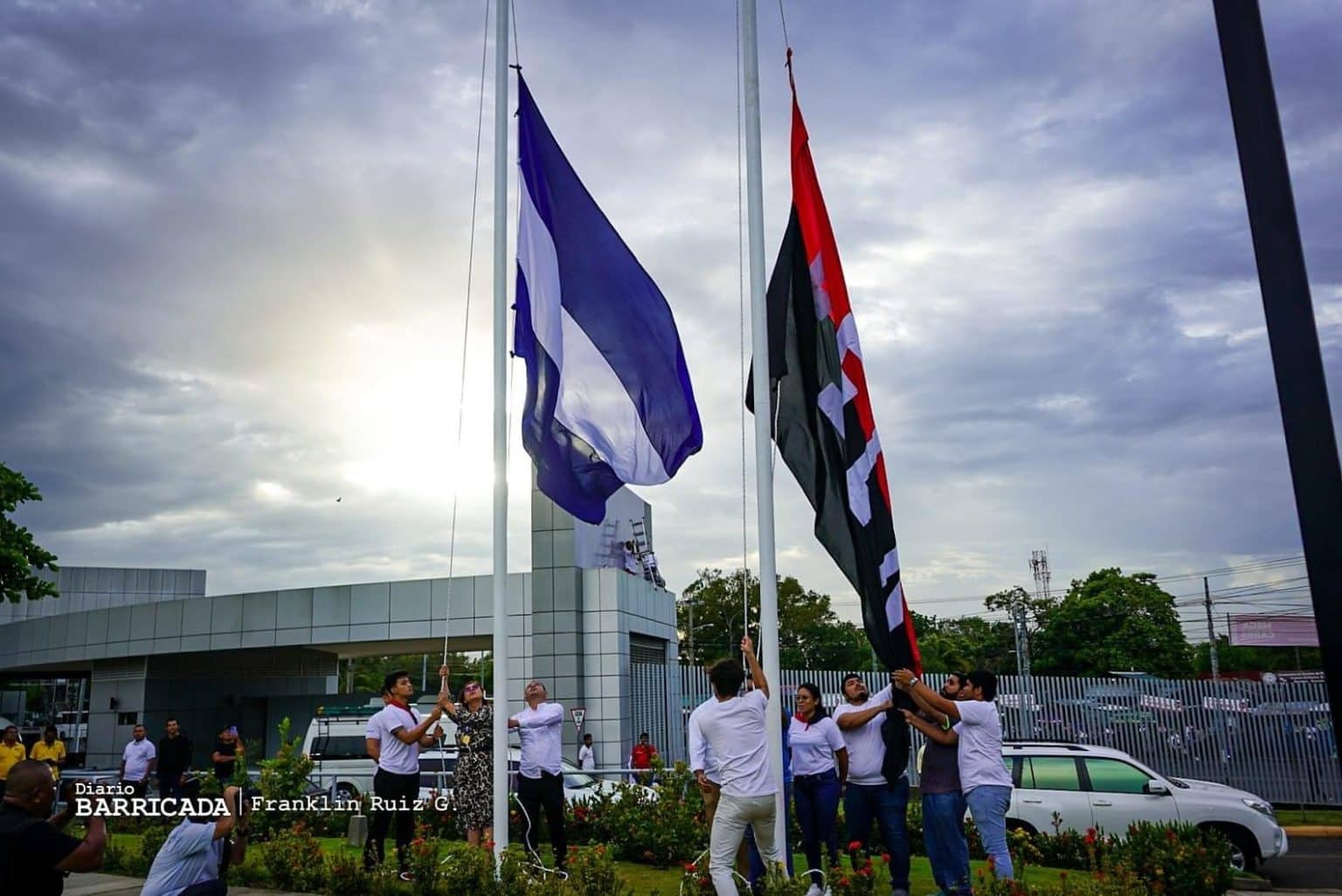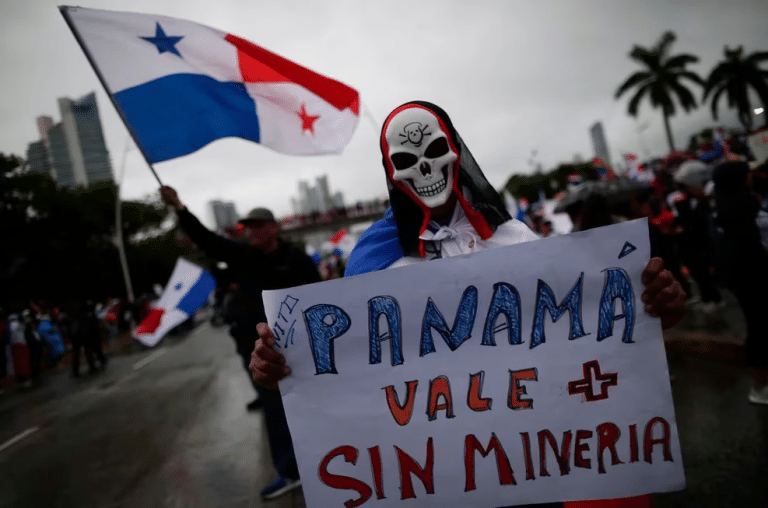9 de noviembre 2023

European Concern over Lack of Academic Freedom in Nicaragua

PUBLICIDAD 1M
PUBLICIDAD 4D
PUBLICIDAD 5D

Un cartel de protesta durante una manifestación por la concesión minera en Panamá, en octubre de 2023. // Foto: EFE
Panama is facing its biggest political crisis since its transition to democracy in the 1990s, with massive demonstrations and gatherings throughout the country, plus roadblocks that have closed off the main roads. The turmoil has generated shortages in shops and gas stations, caused the closure of schools and universities, and is causing significant economic losses, according to the Chamber of Commerce. There’s also been picketing in front of the mine, and protests against political representatives, including at the residence of the President himself in the province of Colon.
On Friday, October 20, 2023, the National Assembly approved a contract with Minera Panama (a subsidiary of the Canadian company First Quantum Minerals), thereby ratifying Law 406. This lightning-fast approval process which took only two days and ignored various sectors of the population has now generated resounding popular rejection.
The response from sectors opposing the mines was quick, with a call for a national protest on Sunday, October 22, organized by groups such as SUNTRACS (the largest construction workers union), ASOPROF (the teachers association) or Sal de las Redes (youth organization), in addition to dozens of other organizations throughout the country. These have all united with the aim of repealing Law 406 and approving a mining moratorium.
The protests denounced the environmental impact of such open-pit mining activity on the country. Critics have also pointed out that the contract awards arbitrary advantages to the company, such as the possibility of expropriating land within and outside the adjudicated area, tax exemptions, management of ports and airports, and a lack of future government auditing, among others. A large sector of Panama’s citizens see these provisions as evidence that the mining project comprises a colonial enclave controlled by a foreign power, recalling the struggles of the last century to recover the Canal.
In the face of the massive public rejection, the government has framed the mining contract as an opportunity to confront the costs of pension payments, in the context of the financial problems the Panamanian Social Security System is having.
In the past, Panama has been a country characterized by political stability and the absence of large conflicts. In the 90s, the country’s former first vice president, Ricardo Aria Calderon, termed Panama “a country that’s not confrontational.” Yet in the last 16 months, Panama has seen two of the largest citizen mobilizations in its history. The rise of the protests was related to the long Covid-19 quarantine in Panama, among the strictest in the region. The pandemic restrictions caused the country’s GNP to shrink by 17.9%.
According to a report from the International Development Bank: “Social Impact of the Covid-19 pandemic in Panama and analysis of the efficiency of money transfer programs,” in 2020, poverty increased 12.5% in the country, and extreme poverty in 6.8%. At the same time, the middle class shrank nearly 11%, and the Gini index (a measure intended to reflect income inequality within a nation or social group) increased 3.8 points, leaving the country at 54.1.
Beyond the sociio-economic effects, something in the social order also seems to have broken during the quarantines. Like a kind of earthquake, the measures adopted to deal with the pandemic apparently exacerbated other problems, such as general mistrust of the poor management of public funds. In the Second Survey of Citizenry and Rights that the International Center for Political and Social Studies (CIEPS) conducted in 2021, corruption had come to be viewed as the country’s principal problem. The pandemic had a destabilizing effect on the Panamanian social order, hindering its normal reproduction and making it more difficult for certain inertias and traditional ways of functioning to continue operating.
In 2022, protests over rising prices broke out all over the country. That’s when the large alliances of professionals, teachers, doctors, construction workers, indigenous peoples, and anonymous citizens were constructed. But in the case of the October 2023 protests, other sectors joined in with these alliances, including more affluent sectors, and demonstrations were even held in wealthy neighborhoods such as Clayton. Also, not only did these unanticipated interruptions exist, but even associations like those of doctors and lawyers have held demonstrations against the mining contract, thus giving the protests a cross-sectional character.
At the same time, the role of the youth has stood out, since young people have led many of the marches and demonstrations. In the opinion polls, Panamanian youth show a high grade of alienation from democracy, the institutions and the traditional mechanisms of political participation. On the other hand, however, they express a high level of environmental consciousness, and – in larger measure than the rest of the age groups – they prioritize protecting nature over economic growth, even taking into consideration that this awareness is massive across all age groups, according to data from the CIEPS Survey of Citizenry and Rights.
In addition to the participation of more diverse sectors, the presence of new actors, and the prominent role of young people, the main difference between the mobilizations of July 2022 and those of October 2023 is that in the first case the objective was to demand new proposals: measures to lower the cost of fuel, basic consumer goods and energy; compliance with the agreed-upon educational investment; and improved accessibility to medicines, among others. In contrast, the new protests are characterized by opposition: a rejection of the mining contract; an end to extractivism; a challenge to a way of governing that serves spurious interests.
In other words, the current protests comprise a big NO. This type of overall rejection makes it difficult for the government to utilize the system of permanent and isolated arrangements with specific groups that has characterized past formulas for resolving conflicts. This transactional logic has entered into crisis and is no longer operational, since it is not capable of addressing the collective, general solutions the population is asking for.
Before the pandemic, Panama had a successful economic model in terms of growth that revolved around the broadening of the Canal and the outside activities this generated. However, once the broadening was concluded, and the death of the goose that lays the golden eggs – What should be the next model? The strong protests make it clear that the population doesn’t want mining. But if extractivism isn’t the model that can offer a response to the demand for sustainable economic development, needed attention to the historic social debts, and the imperative for a transparent, trustworthy government without spurious interests, then one of the most important questions that Panamanian society must answer, especially at a moment when the 2024 general elections are nearing, is: What, then, could be the alternative?
This article was originally published in Spanish in Confidencial and translated by Havana Times. To get the most relevant news from our English coverage delivered straight to your inbox, subscribe to The Dispatch.
PUBLICIDAD 3M
Investigador del Centro Internacional de Estudios Políticos y Sociales, AIP de Panamá. Doctor en Sociología y Antropología por la Universidad Complutense de Madrid. Experto en estudios de opinión pública.
PUBLICIDAD 3D